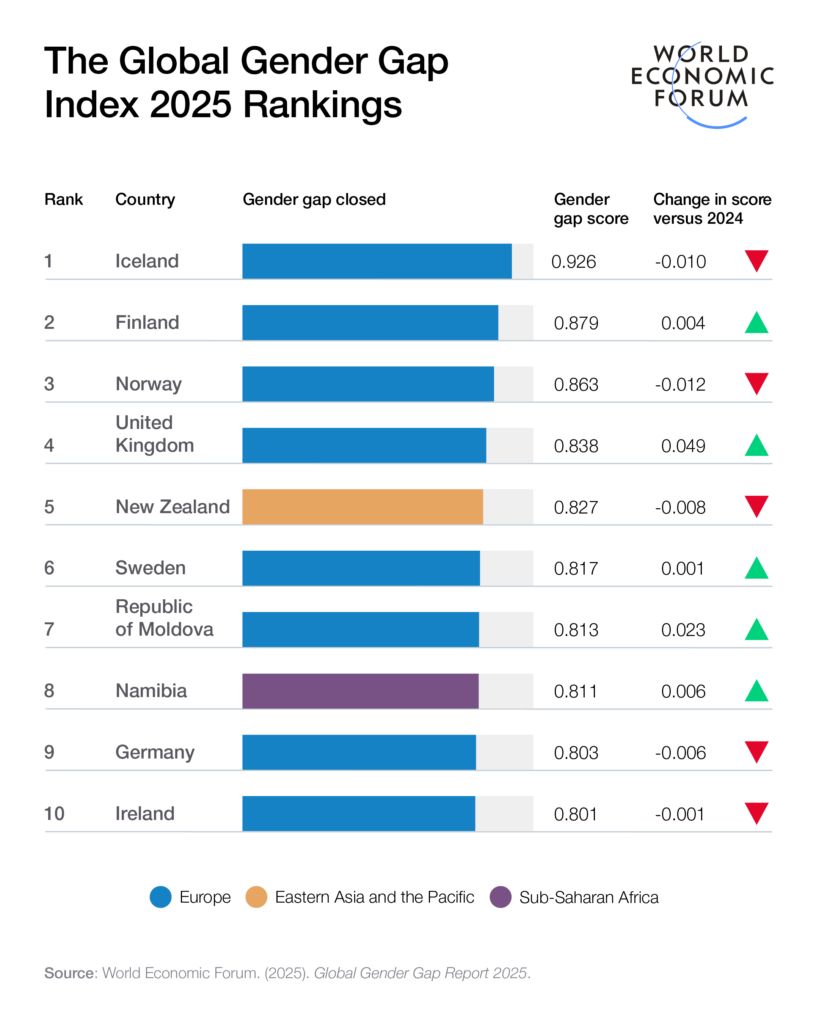According to the World Economic Forum’s Global Gender Gap Report 2025, the global gender gap has narrowed to 68.8%, the fastest rate of progress recorded since the pandemic. However, despite this improvement, true gender parity remains a distant prospect—an estimated 123 years away at the current pace of change.
While women now surpass men in higher education attainment, they continue to be significantly underrepresented in senior leadership, occupying just 28.8% of such positions globally. This represents a missed opportunity for economies striving for greater resilience, innovation, and sustainable growth in uncertain times.
Political representation has shown the greatest year-on-year improvement, but remains the most underdeveloped area. Only 22.9% of the global political empowerment gap has been closed, making it the most significant obstacle to achieving full parity worldwide.
The report, covering 148 economies, places Iceland at the top for the 16th consecutive year with 92.6% of its gender gap closed. It remains the only country to exceed the 90% threshold. Finland, Norway, the UK (with a score of 83.8%), and New Zealand round out the top five. All ten leading nations have closed over 80% of their gender gaps, with European countries occupying eight of those positions. Iceland, Finland, Norway, and Sweden have consistently been in the top 10 since 2006.
Encouragingly, the report indicates that both educational attainment and health outcomes are nearing parity, each exceeding 95%. Yet, despite women comprising over 41% of the global workforce, their underrepresentation in leadership roles remains stark and persistent.
Saadia Zahidi, Managing Director at the World Economic Forum, noted that amid economic uncertainty, low growth, and technological upheaval, gender parity is not just a social goal but an economic necessity. Nations making meaningful progress in this area are better positioned for long-term prosperity.
Wealth and Parity – Not Always Linked
The index measures gender-based disparities in outcomes, not overall wealth or opportunity. While higher-income countries tend to show slightly narrower gender gaps—with an average of 74.3% of the gap closed—this correlation is limited. Several lower-income nations outperform many wealthier counterparts, demonstrating that achieving gender parity is possible at all stages of development. The key lies not in GDP, but in actively embedding parity into national growth strategies.
Regional Highlights
North America leads globally with a score of 75.8%, thanks to strong economic participation (76.1%) and notable gains in political representation. Europe follows closely with a 75.1% score and the world’s highest level of political empowerment (35.4%). Since 2006, Europe has improved its gender parity by over six percentage points.
Latin America and the Caribbean are the fastest-improving regions, now at 74.5%—an 8.6 percentage point increase since 2006. Central Asia comes next with a score of 69.8%, with Armenia and Georgia leading within the region.
East Asia and the Pacific follow with 69.4%. New Zealand, Australia, and the Philippines top the regional rankings, with New Zealand the only one in the global top 10. Sub-Saharan Africa sits at 68.0%, with progress in political empowerment reflected by women holding over 40% of ministerial roles and nearly 38% of parliamentary seats.
South Asia ranks seventh with 64.6%; Bangladesh, at 77.5%, remains the region’s highest performer and the only South Asian country in the global top 50. Finally, the Middle East and North Africa come in last with 61.7%, though the region has more than tripled its political empowerment score since 2006.
Progress Still Too Slow
Though the pace of improvement has quickened, projections remain sobering. Based on the 100 economies continuously tracked since 2006, global gender parity is still over a century away. Political parity is the slowest-moving area: despite a 9-point gain since 2006, it will take 162 years to close the gap at current rates. Economic parity, having improved by 5.6 points, remains 135 years away.
However, the success of nations like Saudi Arabia, Mexico, Ecuador, Bangladesh, and Ethiopia within their respective income groups shows that targeted interventions can deliver swift change when gender parity is treated as a strategic national goal.
Emerging Risks from Technological and Economic Shifts
As global trade patterns evolve and AI reshapes the workforce, there are growing concerns that women’s economic gains could reverse. In lower- and middle-income countries, many women have moved into better-paid formal work—particularly in export-driven industries—which are now vulnerable to disruptions. As seen during the COVID-19 pandemic, the impact of trade shocks tends to last longer for women, exacerbating pre-existing inequalities in income and opportunity.
Therefore, it’s critical that policymakers factor in the gendered impact of trade fragmentation and technological disruption in future economic planning.
Wasted Potential in the Leadership Pipeline
Although more women than men are attaining higher education, this is not translating into leadership roles. Even among the most highly educated, women make up less than a third of senior executives—a systemic inefficiency with significant economic consequences.
Sue Duke of LinkedIn highlights the urgency: “In an economy increasingly shaped by AI and innovation, the human skills and diverse insights women bring to leadership are being overlooked at precisely the moment they’re most needed.”
Career paths are also changing. Leadership roles are increasingly filled by individuals with broad experience across different sectors or job functions, rather than following traditional vertical career ladders. This shift poses additional challenges for women, who are 55% more likely than men to take career breaks—typically for caregiving responsibilities—and who spend on average six months more out of the workforce.
This evolving reality calls for a more flexible approach to career development and re-entry, especially if economies are to tap into the full spectrum of available talent.
The Global Gender Gap Report—now in its 19th year—is the most established measure of gender-based disparities across economic participation, education, health, and politics. This year’s edition analyses data from 148 economies, covering more than two-thirds of the world’s population. It draws from datasets compiled by global institutions including the ILO, UNESCO, UN Women, the World Bank, the WHO, and LinkedIn’s Economic Graph.
The report supports the Global Gender Parity Sprint to 2030, a World Economic Forum platform that mobilises a coalition of businesses, governments, and international organizations to accelerate progress on economic gender parity.










Was under the impression dailysquib prefers satirising woke globalist propaganda, as opposed to promoting it.
My wife’s in the kitchen where she belongs. I’m not going to show her this article lol